Full text
PDF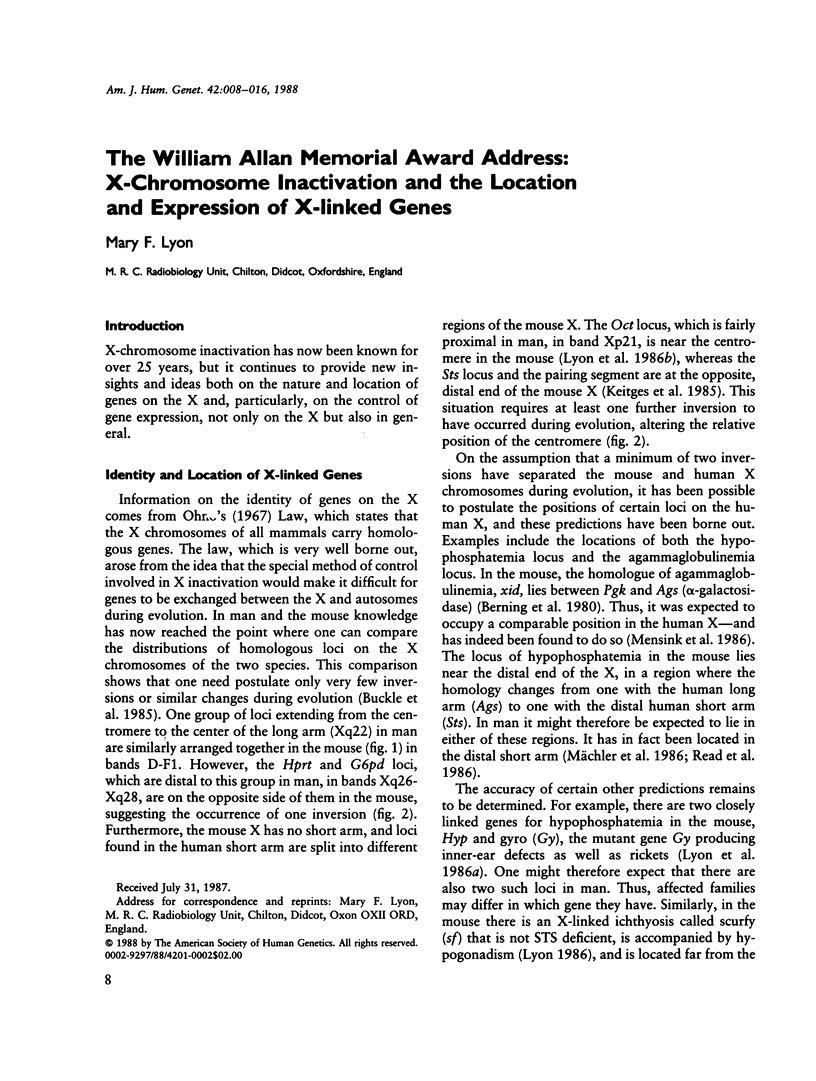
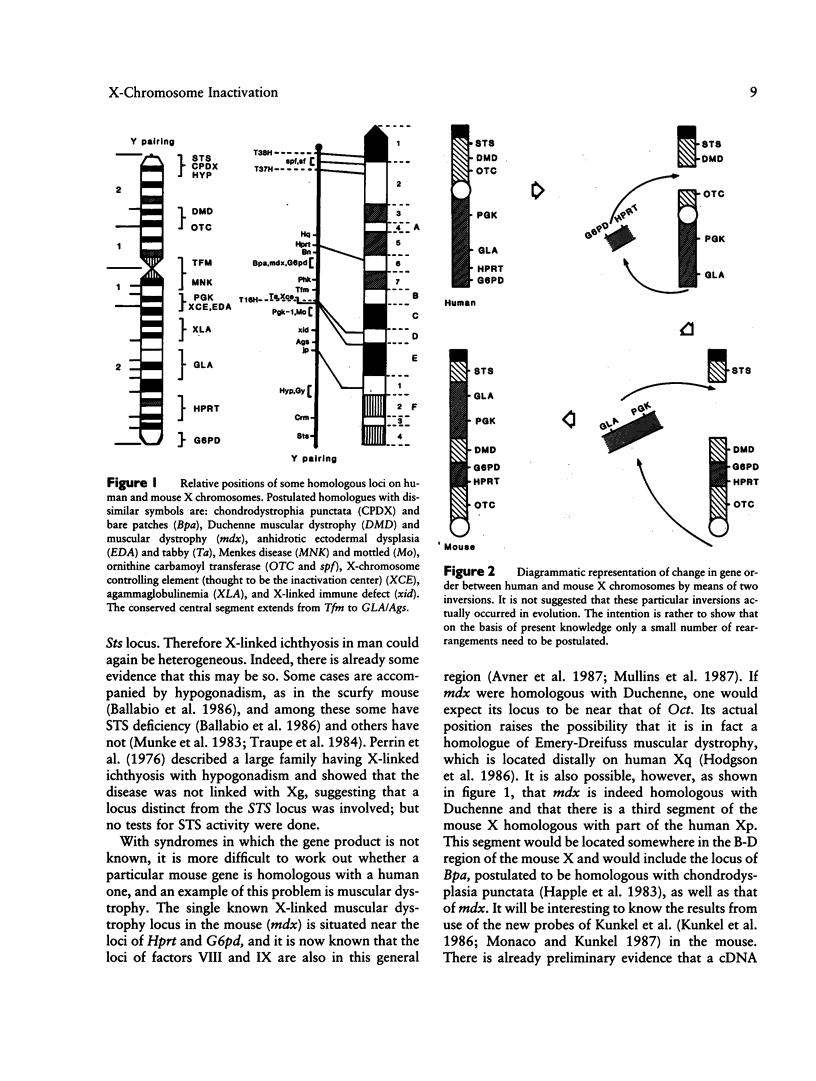
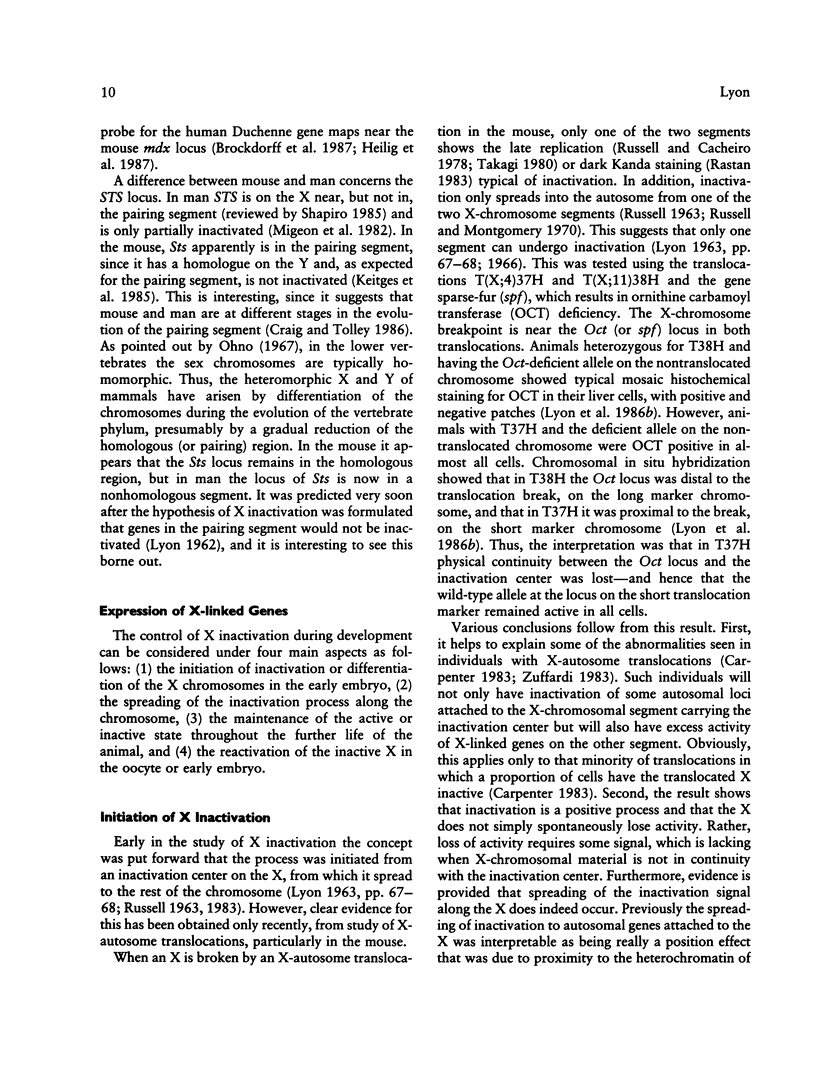
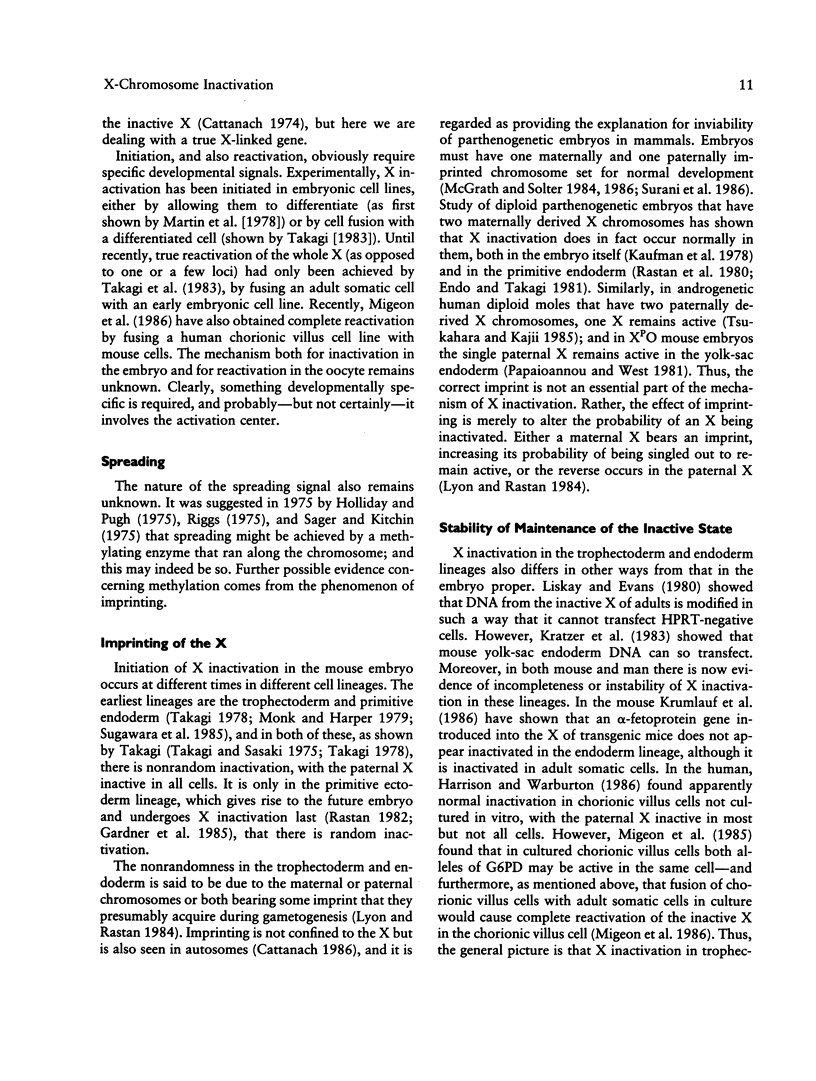
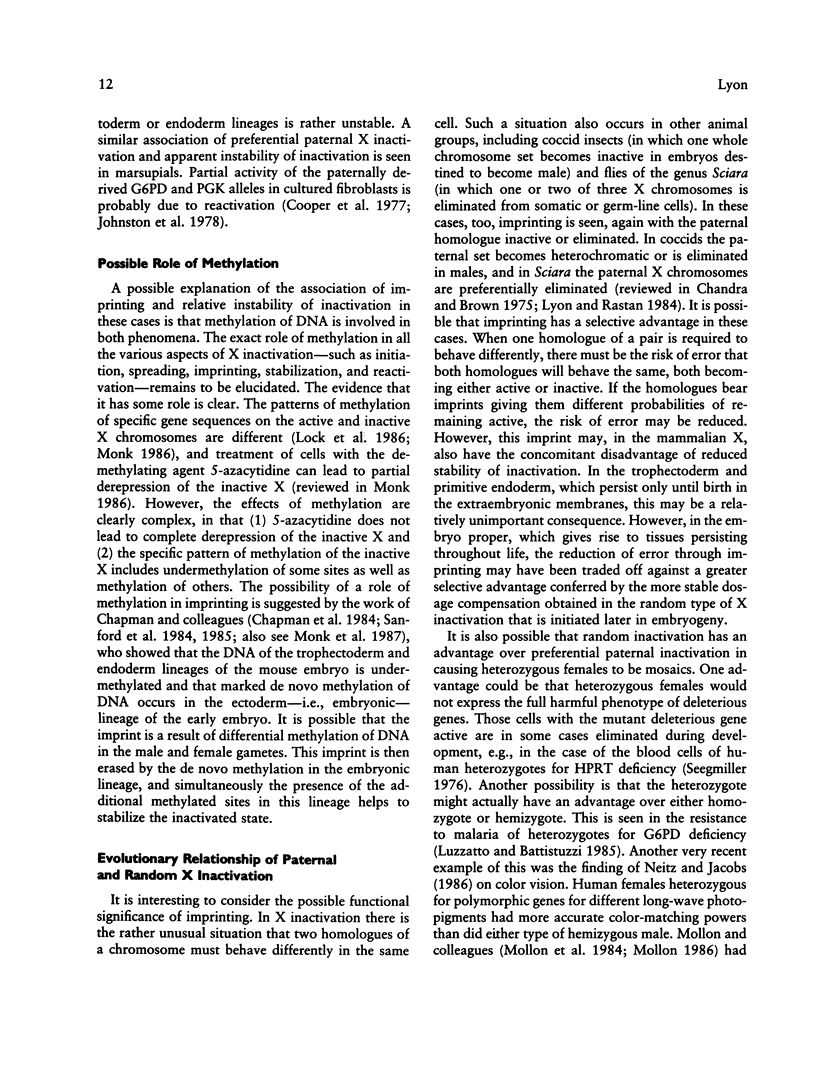

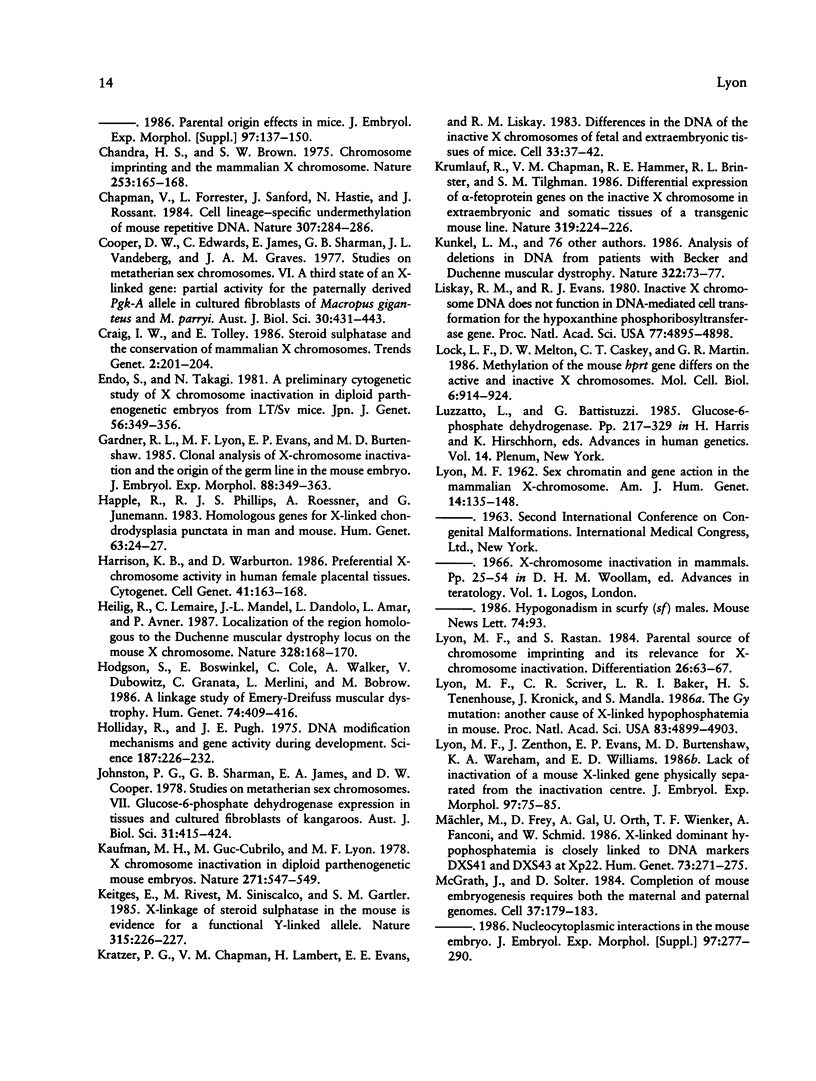
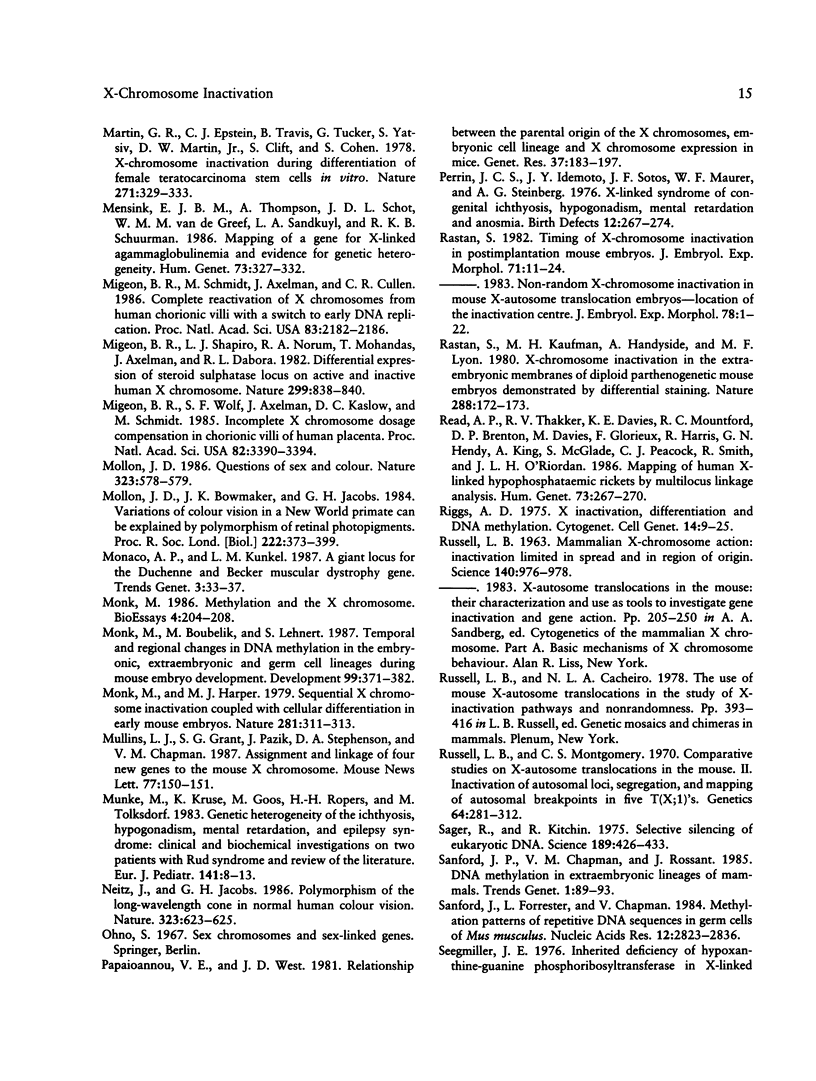
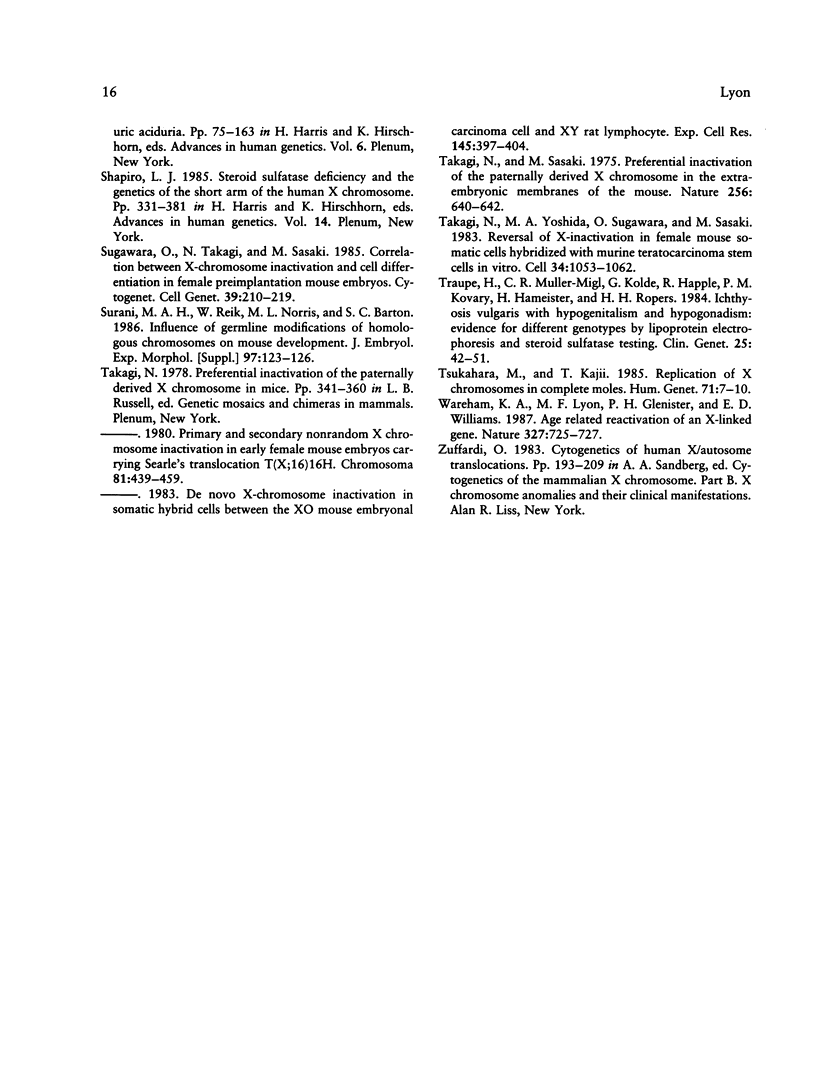
Selected References
These references are in PubMed. This may not be the complete list of references from this article.
- Avner P., Amar L., Arnaud D., Hanauer A., Cambrou J. Detailed ordering of markers localizing to the Xq26-Xqter region of the human X chromosome by the use of an interspecific Mus spretus mouse cross. Proc Natl Acad Sci U S A. 1987 Mar;84(6):1629–1633. doi: 10.1073/pnas.84.6.1629. [DOI] [PMC free article] [PubMed] [Google Scholar]
- Ballabio A., Parenti G., Tippett P., Mondello C., Di Maio S., Tenore A., Andria G. X-linked ichthyosis, due to steroid sulphatase deficiency, associated with Kallmann syndrome (hypogonadotropic hypogonadism and anosmia): linkage relationships with Xg and cloned DNA sequences from the distal short arm of the X chromosome. Hum Genet. 1986 Mar;72(3):237–240. doi: 10.1007/BF00291885. [DOI] [PubMed] [Google Scholar]
- Berning A. K., Eicher E. M., Paul W. E., Scher I. Mapping of the X-linked immune deficiency mutation (xid) of CBA/N mice. J Immunol. 1980 Apr;124(4):1875–1877. [PubMed] [Google Scholar]
- Brockdorff N., Cross G. S., Cavanna J. S., Fisher E. M., Lyon M. F., Davies K. E., Brown S. D. The mapping of a cDNA from the human X-linked Duchenne muscular dystrophy gene to the mouse X chromosome. Nature. 1987 Jul 9;328(6126):166–168. doi: 10.1038/328166a0. [DOI] [PubMed] [Google Scholar]
- Cattanach B. M. Position effect variegation in the mouse. Genet Res. 1974 Jun;23(3):291–306. doi: 10.1017/s0016672300014932. [DOI] [PubMed] [Google Scholar]
- Chandra H. S., Brown S. W. Chromosome imprinting and the mammalian X chromosome. Nature. 1975 Jan 17;253(5488):165–168. doi: 10.1038/253165a0. [DOI] [PubMed] [Google Scholar]
- Chapman V., Forrester L., Sanford J., Hastie N., Rossant J. Cell lineage-specific undermethylation of mouse repetitive DNA. Nature. 1984 Jan 19;307(5948):284–286. doi: 10.1038/307284a0. [DOI] [PubMed] [Google Scholar]
- Gardner R. L., Lyon M. F., Evans E. P., Burtenshaw M. D. Clonal analysis of X-chromosome inactivation and the origin of the germ line in the mouse embryo. J Embryol Exp Morphol. 1985 Aug;88:349–363. [PubMed] [Google Scholar]
- Happle R., Phillips R. J., Roessner A., Jünemann G. Homologous genes for X-linked chondrodysplasia punctata in man and mouse. Hum Genet. 1983;63(1):24–27. doi: 10.1007/BF00285392. [DOI] [PubMed] [Google Scholar]
- Harrison K. B., Warburton D. Preferential X-chromosome activity in human female placental tissues. Cytogenet Cell Genet. 1986;41(3):163–168. doi: 10.1159/000132221. [DOI] [PubMed] [Google Scholar]
- Heilig R., Lemaire C., Mandel J. L., Dandolo L., Amar L., Avner P. Localization of the region homologous to the Duchenne muscular dystrophy locus on the mouse X chromosome. Nature. 1987 Jul 9;328(6126):168–170. doi: 10.1038/328168a0. [DOI] [PubMed] [Google Scholar]
- Hodgson S., Boswinkel E., Cole C., Walker A., Dubowitz V., Granata C., Merlini L., Bobrow M. A linkage study of Emery-Dreifuss muscular dystrophy. Hum Genet. 1986 Dec;74(4):409–416. doi: 10.1007/BF00280495. [DOI] [PubMed] [Google Scholar]
- Holliday R., Pugh J. E. DNA modification mechanisms and gene activity during development. Science. 1975 Jan 24;187(4173):226–232. [PubMed] [Google Scholar]
- Kaufman M. H., Guc-Cubrilo M., Lyon M. F. X chromosome inactivation in diploid parthenogenetic mouse embryos. Nature. 1978 Feb 9;271(5645):547–549. doi: 10.1038/271547a0. [DOI] [PubMed] [Google Scholar]
- Keitges E., Rivest M., Siniscalco M., Gartler S. M. X-linkage of steroid sulphatase in the mouse is evidence for a functional Y-linked allele. Nature. 1985 May 16;315(6016):226–227. doi: 10.1038/315226a0. [DOI] [PubMed] [Google Scholar]
- Kratzer P. G., Chapman V. M., Lambert H., Evans R. E., Liskay R. M. Differences in the DNA of the inactive X chromosomes of fetal and extraembryonic tissues of mice. Cell. 1983 May;33(1):37–42. doi: 10.1016/0092-8674(83)90332-x. [DOI] [PubMed] [Google Scholar]
- Krumlauf R., Chapman V. M., Hammer R. E., Brinster R., Tilghman S. M. Differential expression of alpha-fetoprotein genes on the inactive X chromosome in extraembryonic and somatic tissues of a transgenic mouse line. Nature. 1986 Jan 16;319(6050):224–226. doi: 10.1038/319224a0. [DOI] [PubMed] [Google Scholar]
- Kunkel L. M., Hejtmancik J. F., Caskey C. T., Speer A., Monaco A. P., Middlesworth W., Colletti C. A., Bertelson C., Müller U., Bresnan M. Analysis of deletions in DNA from patients with Becker and Duchenne muscular dystrophy. Nature. 1986 Jul 3;322(6074):73–77. doi: 10.1038/322073a0. [DOI] [PubMed] [Google Scholar]
- LYON M. F. Sex chromatin and gene action in the mammalian X-chromosome. Am J Hum Genet. 1962 Jun;14:135–148. [PMC free article] [PubMed] [Google Scholar]
- Liskay R. M., Evans R. J. Inactive X chromosome DNA does not function in DNA-mediated cell transformation for the hypoxanthine phosphoribosyltransferase gene. Proc Natl Acad Sci U S A. 1980 Aug;77(8):4895–4898. doi: 10.1073/pnas.77.8.4895. [DOI] [PMC free article] [PubMed] [Google Scholar]
- Lock L. F., Melton D. W., Caskey C. T., Martin G. R. Methylation of the mouse hprt gene differs on the active and inactive X chromosomes. Mol Cell Biol. 1986 Mar;6(3):914–924. doi: 10.1128/mcb.6.3.914. [DOI] [PMC free article] [PubMed] [Google Scholar]
- Luzzatto L., Battistuzzi G. Glucose-6-phosphate dehydrogenase. Adv Hum Genet. 1985;14:217-329, 386-8. doi: 10.1007/978-1-4615-9400-0_4. [DOI] [PubMed] [Google Scholar]
- Lyon M. F., Rastan S. Parental source of chromosome imprinting and its relevance for X chromosome inactivation. Differentiation. 1984;26(1):63–67. doi: 10.1111/j.1432-0436.1984.tb01375.x. [DOI] [PubMed] [Google Scholar]
- Lyon M. F., Scriver C. R., Baker L. R., Tenenhouse H. S., Kronick J., Mandla S. The Gy mutation: another cause of X-linked hypophosphatemia in mouse. Proc Natl Acad Sci U S A. 1986 Jul;83(13):4899–4903. doi: 10.1073/pnas.83.13.4899. [DOI] [PMC free article] [PubMed] [Google Scholar]
- Lyon M. F., Zenthon J., Evans E. P., Burtenshaw M. D., Wareham K. A., Williams E. D. Lack of inactivation of a mouse X-linked gene physically separated from the inactivation centre. J Embryol Exp Morphol. 1986 Sep;97:75–85. [PubMed] [Google Scholar]
- Martin G. R., Epstein C. J., Travis B., Tucker G., Yatziv S., Martin D. W., Jr, Clift S., Cohen S. X-chromosome inactivation during differentiation of female teratocarcinoma stem cells in vitro. Nature. 1978 Jan 26;271(5643):329–333. doi: 10.1038/271329a0. [DOI] [PubMed] [Google Scholar]
- McGrath J., Solter D. Completion of mouse embryogenesis requires both the maternal and paternal genomes. Cell. 1984 May;37(1):179–183. doi: 10.1016/0092-8674(84)90313-1. [DOI] [PubMed] [Google Scholar]
- Mensink E. J., Thompson A., Schot J. D., van de Greef W. M., Sandkuyl L. A., Schuurman R. K. Mapping of a gene for X-linked agammaglobulinemia and evidence for genetic heterogeneity. Hum Genet. 1986 Aug;73(4):327–332. doi: 10.1007/BF00279095. [DOI] [PubMed] [Google Scholar]
- Migeon B. R., Schmidt M., Axelman J., Cullen C. R. Complete reactivation of X chromosomes from human chorionic villi with a switch to early DNA replication. Proc Natl Acad Sci U S A. 1986 Apr;83(7):2182–2186. doi: 10.1073/pnas.83.7.2182. [DOI] [PMC free article] [PubMed] [Google Scholar]
- Migeon B. R., Shapiro L. J., Norum R. A., Mohandas T., Axelman J., Dabora R. L. Differential expression of steroid sulphatase locus on active and inactive human X chromosome. Nature. 1982 Oct 28;299(5886):838–840. doi: 10.1038/299838a0. [DOI] [PubMed] [Google Scholar]
- Migeon B. R., Wolf S. F., Axelman J., Kaslow D. C., Schmidt M. Incomplete X chromosome dosage compensation in chorionic villi of human placenta. Proc Natl Acad Sci U S A. 1985 May;82(10):3390–3394. doi: 10.1073/pnas.82.10.3390. [DOI] [PMC free article] [PubMed] [Google Scholar]
- Mollon J. D., Bowmaker J. K., Jacobs G. H. Variations of colour vision in a New World primate can be explained by polymorphism of retinal photopigments. Proc R Soc Lond B Biol Sci. 1984 Sep 22;222(1228):373–399. doi: 10.1098/rspb.1984.0071. [DOI] [PubMed] [Google Scholar]
- Mollon J. D. Perception. Questions of sex and colour. Nature. 1986 Oct 16;323(6089):578–579. doi: 10.1038/323578a0. [DOI] [PubMed] [Google Scholar]
- Monk M., Boubelik M., Lehnert S. Temporal and regional changes in DNA methylation in the embryonic, extraembryonic and germ cell lineages during mouse embryo development. Development. 1987 Mar;99(3):371–382. doi: 10.1242/dev.99.3.371. [DOI] [PubMed] [Google Scholar]
- Monk M., Harper M. I. Sequential X chromosome inactivation coupled with cellular differentiation in early mouse embryos. Nature. 1979 Sep 27;281(5729):311–313. doi: 10.1038/281311a0. [DOI] [PubMed] [Google Scholar]
- Monk M. Methylation and the X chromosome. Bioessays. 1986 May;4(5):204–208. doi: 10.1002/bies.950040505. [DOI] [PubMed] [Google Scholar]
- Mächler M., Frey D., Gal A., Orth U., Wienker T. F., Fanconi A., Schmid W. X-linked dominant hypophosphatemia is closely linked to DNA markers DXS41 and DXS43 at Xp22. Hum Genet. 1986 Jul;73(3):271–275. doi: 10.1007/BF00401243. [DOI] [PubMed] [Google Scholar]
- Münke M., Kruse K., Goos M., Ropers H. H., Tolksdorf M. Genetic heterogeneity of the ichthyosis, hypogonadism, mental retardation, and epilepsy syndrome. Clinical and biochemical investigations on two patients with Rud syndrome and review of the literature. Eur J Pediatr. 1983 Oct;141(1):8–13. doi: 10.1007/BF00445661. [DOI] [PubMed] [Google Scholar]
- Neitz J., Jacobs G. H. Polymorphism of the long-wavelength cone in normal human colour vision. Nature. 1986 Oct 16;323(6089):623–625. doi: 10.1038/323623a0. [DOI] [PubMed] [Google Scholar]
- Papaioannou V. E., West J. D. Relationship between the parental origin of the X chromosomes, embryonic cell lineage and X chromosome expression in mice. Genet Res. 1981 Apr;37(2):183–197. doi: 10.1017/s0016672300020152. [DOI] [PubMed] [Google Scholar]
- Perrin J. C., Idemoto J. Y., Sotos J. F., Maurer W. F., Steinberg A. G. X-linked syndrome of congenital ichthyosis, hypogonadism, mental retardation and anosmia. Birth Defects Orig Artic Ser. 1976;12(5):267–274. [PubMed] [Google Scholar]
- RUSSELL L. B. Mammalian X-chromosome action: inactivation limited in spread and region of origin. Science. 1963 May 31;140(3570):976–978. doi: 10.1126/science.140.3570.976. [DOI] [PubMed] [Google Scholar]
- Rastan S., Kaufman M. H., Handyside A. H., Lyon M. F. X-chromosome inactivation in extra-embryonic membranes of diploid parthenogenetic mouse embryos demonstrated by differential staining. Nature. 1980 Nov 13;288(5787):172–173. doi: 10.1038/288172a0. [DOI] [PubMed] [Google Scholar]
- Rastan S. Timing of X-chromosome inactivation in postimplantation mouse embryos. J Embryol Exp Morphol. 1982 Oct;71:11–24. [PubMed] [Google Scholar]
- Read A. P., Thakker R. V., Davies K. E., Mountford R. C., Brenton D. P., Davies M., Glorieux F., Harris R., Hendy G. N., King A. Mapping of human X-linked hypophosphataemic rickets by multilocus linkage analysis. Hum Genet. 1986 Jul;73(3):267–270. doi: 10.1007/BF00401242. [DOI] [PubMed] [Google Scholar]
- Riggs A. D. X inactivation, differentiation, and DNA methylation. Cytogenet Cell Genet. 1975;14(1):9–25. doi: 10.1159/000130315. [DOI] [PubMed] [Google Scholar]
- Russell L. B., Cacheiro N. L. The use of mouse X-autosome translocations in the study of X-inactivation pathways and nonrandomness. Basic Life Sci. 1978;12:393–416. doi: 10.1007/978-1-4684-3390-6_27. [DOI] [PubMed] [Google Scholar]
- Russell L. B., Montgomery C. S. Comparative studies on X-autosome translocations in the mouse. II. Inactivation of autosomal loci, segregation, and mapping of autosomal breakpoints in five T (X;1) S. Genetics. 1970 Feb;64(2):281–312. doi: 10.1093/genetics/64.2.281. [DOI] [PMC free article] [PubMed] [Google Scholar]
- Sager R., Kitchin R. Selective silencing of eukaryotic DNA. Science. 1975 Aug 8;189(4201):426–433. [PubMed] [Google Scholar]
- Sanford J., Forrester L., Chapman V., Chandley A., Hastie N. Methylation patterns of repetitive DNA sequences in germ cells of Mus musculus. Nucleic Acids Res. 1984 Mar 26;12(6):2823–2836. doi: 10.1093/nar/12.6.2823. [DOI] [PMC free article] [PubMed] [Google Scholar]
- Shapiro L. J. Steroid sulfatase deficiency and the genetics of the short arm of the human X chromosome. Adv Hum Genet. 1985;14:331-81, 388-9. doi: 10.1007/978-1-4615-9400-0_5. [DOI] [PubMed] [Google Scholar]
- Sugawara O., Takagi N., Sasaki M. Correlation between X-chromosome inactivation and cell differentiation in female preimplantation mouse embryos. Cytogenet Cell Genet. 1985;39(3):210–219. doi: 10.1159/000132137. [DOI] [PubMed] [Google Scholar]
- Surani M. A., Reik W., Norris M. L., Barton S. C. Influence of germline modifications of homologous chromosomes on mouse development. J Embryol Exp Morphol. 1986 Oct;97 (Suppl):123–136. [PubMed] [Google Scholar]
- Takagi N. Preferential inactivation of the paternally derived X chromosome in mice. Basic Life Sci. 1978;12:341–360. doi: 10.1007/978-1-4684-3390-6_24. [DOI] [PubMed] [Google Scholar]
- Takagi N., Sasaki M. Preferential inactivation of the paternally derived X chromosome in the extraembryonic membranes of the mouse. Nature. 1975 Aug 21;256(5519):640–642. doi: 10.1038/256640a0. [DOI] [PubMed] [Google Scholar]
- Takagi N., Yoshida M. A., Sugawara O., Sasaki M. Reversal of X-inactivation in female mouse somatic cells hybridized with murine teratocarcinoma stem cells in vitro. Cell. 1983 Oct;34(3):1053–1062. doi: 10.1016/0092-8674(83)90563-9. [DOI] [PubMed] [Google Scholar]
- Traupe H., Müller-Migl C. R., Kolde G., Happle R., Kövary P. M., Hameister H., Ropers H. H. Ichthyosis vulgaris with hypogenitalism and hypogonadism: evidence for different genotypes by lipoprotein electrophoresis and steroid sulfatase testing. Clin Genet. 1984 Jan;25(1):42–51. doi: 10.1111/j.1399-0004.1984.tb00461.x. [DOI] [PubMed] [Google Scholar]
- Tsukahara M., Kajii T. Replication of X chromosomes in complete moles. Hum Genet. 1985;71(1):7–10. doi: 10.1007/BF00295658. [DOI] [PubMed] [Google Scholar]
- Wareham K. A., Lyon M. F., Glenister P. H., Williams E. D. Age related reactivation of an X-linked gene. 1987 Jun 25-Jul 1Nature. 327(6124):725–727. doi: 10.1038/327725a0. [DOI] [PubMed] [Google Scholar]


